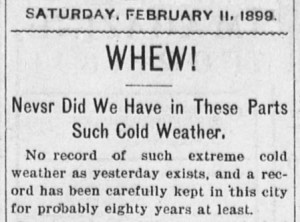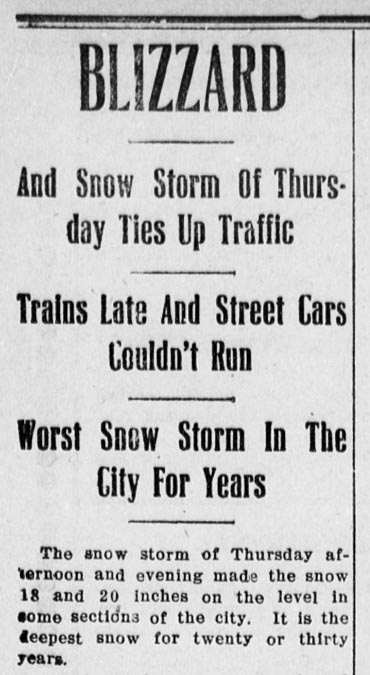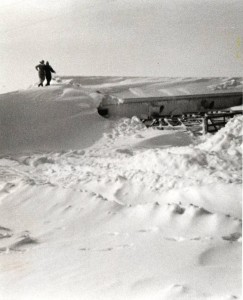Oh, the Weather Outside is Frightful…


I used to love the snow when I was younger. Building snowmen, having snowball fights, sledding, and most importantly, NO SCHOOL! As an adult, my feelings about snow have changed. I no longer have a hill to sled down, my wife doesn’t like to participate in snowball fights (I play to win!), and I don’t get a day off from work because it’s snowing a few inches. Ohio is an interesting place when it comes to winter weather. Some years we get lucky and have a pretty mild season; others, we get snow dumped on us by the truckload. Looking back through the years in photos and newspapers, Ohio has had some pretty intense winter weather.
As we’ve seen over the last week, the months of January and February can get pretty cold, but on February 10, 1899, the record low temperature for Ohio hit rock bottom. At -39°F in Milligan, Ohio, (Milligan no longer exists–it is now a part of McLuney, Ohio) this record still stands to this day. During a cold snap that passed through Ohio from February 8-15 of that year, the mercury struggled to stay above zero all across the entire state.

A winter storm in February of 1910 set records at the time for the snowiest month ever for several Ohio cities. The storm started on the night of the 16th and did not stop until the 18th. The majority of the state accumulated anywhere from 10-20 inches of snow from this storm, and some cities got more than that. Urbana was treated to 25 inches of snow, and the cities of Marion and Canton each received 22 inches. The city of Dayton had a total of 31 inches of snow during that month, with Columbus not far behind at 29 inches.
With so much snow falling, street sweepers could not keep up with the accumulation and eventually transportation was halted. Trains were running 12 hours late, and that was only if they were not stranded in snow drifts to later be abandoned by the passengers. Despite the unofficial motto of “Neither snow, nor rain, nor heat…,” the postal service even canceled mail delivery. When the post office stops delivering your mail, that’s when you know the weather is bad!
In 1913, from November 9-11, a “white” hurricane struck the Great Lakes, destroying a large number of boats, and killing at least 235 sailors. The wind was recorded at speeds of 79 mph in Cleveland, and the skies dropped 22 inches of snow in the area (up to 25 inches in other parts of Ohio) over a two-day span. Trains and trucks that were transporting food were stranded, leading to a shortage of milk and other food items. With telegraph lines down, long-distance communication was not possible.

Perhaps the worst winter phenomenon happened in recent memory. Simply called “The Great Blizzard of 1978,” or “The Cleveland Superbomb” due to the incredibly low barometric pressure (28.28), it was called a “severe blizzard” by the National Weather Service. What are the qualifications to make it “severe,” you might ask? The storm must have sustained winds of over 45 miles per hour, visibility close to, or at, zero, and a temperature of 10° F or below, making for some pretty miserable and dangerous conditions. With winds gusting at over 100 miles per hour, homes and vehicles were buried under 25 foot snow drifts. The temperature, with wind chill factor included, reached a brisk -60°F.
This storm impacted several states, with Ohio getting the worst of it. 70 deaths were attributed to this storm, and 51 of those were Ohioans. The Ohio Turnpike was closed for the first time in history, members of the Ohio National Guard were called upon to help with rescue efforts, and transportation came to a standstill. Any citizens with snowmobiles or four-wheel drive vehicles were called upon to help with emergency transportation, and even served as transport for doctors in order to get them to hospitals.
All this talk about winter weather and blizzards has made me cold. I’m going to make a cup of hot chocolate and sit by the fire where it’s so delightful. Stay warm out there!
___________________________________________________________________________________
Thanks toKevin Latta, Quality Control Technician for NDNP-OH, for this week’s timely post! To learn more about the roller coaster ride of weather in Ohio, visit Ohio Memory or Chronicling America and see for yourself how Mother Nature has affected the Buckeye State in years past.



Leave a Reply
You must be logged in to post a comment.